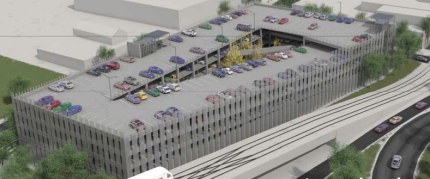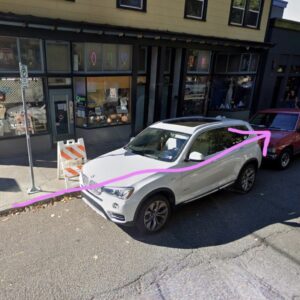
Consultants working on the Columbia River Crossing (CRC) project have revealed plans (PDF here) to build three new park-and-ride facilities in Vancouver. The facilities (which have gotten a cold reception) would include parking capacity for 2,900 motor vehicles.
“Wouldn’t Vancouver rather spend $60 million making it better for people to live in their downtown core, rather than turning it into a car storage area for people from Woodland who are commuting to jobs in downtown Portland?”
— Joe Cortright, economist
The parking garages are being proposed to encourage more Washingtonians to use light rail; but Portland economist Joe Cortright, who has emerged as the project’s most outspoken critic, says the multi-level garages only encourage sprawl, reward car use and are, “Yet another example of how distorted and car-centric this whole project has become.”
Cortright also points out that the cost of those parking spaces comes out to about $60 million.
He gets to that number by multiplying the 2,900 parking spaces by $20,000, which is what many experts estimate as the cost of each space in a parking garage after the total price of construction is figured in*.
Cortright sees that as a “huge subsidy to suburban car drivers.” (It’s unclear whether or not the CRC will charge a fee to use the park-and-rides.)
“Wouldn’t Vancouver rather spend $60 million making it better for people to live in their downtown core,” Cortright wonders, “rather than turning it into a car storage area for people from Woodland who are commuting to jobs in downtown Portland?”
(CRC project staff have not replied to requests for information about an official cost estimate and whether or not they plan to charge a fee to use the park and ride facilities.)
—*Parking cost estimate taken from Transportation Cost and Benefit Analysis II – Parking Costs: Victoria Transport Policy Institute (PDF)







Thanks for reading.
BikePortland has served this community with independent community journalism since 2005. We rely on subscriptions from readers like you to survive. Your financial support is vital in keeping this valuable resource alive and well.
Please subscribe today to strengthen and expand our work.
Anything I’ve ever read in relation to the CRC is a bad idea. Structured parking is like nuclear power and gas stations. We’re not going to know what to do with these in a reasonably short amount of time. We’ll wish we’d spent the money on something closer to what Cortright is suggesting.
Fools.
Considering it’s right by the bridge in an area that won’t have development next to it this is a great idea. The notion that we 100% have to get everyone out of a car and using mass transit is an unrealistic one, especially with Vancouver’s land use patterns over the past half century. Much better to have more vertical parking and have people actually using the max extension.
On the other hand the whole project is still a terrible idea and I hope Vancouver voters kill the max portion of the bridge (and with it the entire project).
Vancouver’s land use patterns over the last half century came to be by huge subsidies to the auto infrastructure, paid for by all of us, and they should not be further subsidized by such expensive structures.
Parking garages are a blight to the neighborhoods they are located in because they destroy street life (thus encouraging crime), prevent multi-use activities, and they are unreconfigurable to other uses. I leave aside the impossibility of designing one that is not hideously ugly.
Also, you say it’s better to have people using the Max, and then say you hope Vancouver voters kill the Max. I’m sure that you have an explanation for this contradiction, right?
I assume he’s referring to the fact that if the voters kill the MAX, the CRC dies with it. No MAX, no CRC.
Talk about ugly! Look at that thing.
Whole approach is wrong here.
Yesterday’s mindset, still fighting the last war, etc.
Keep it up, Cortright! Speak that truth.
Downtown Vantucky = car storage area.
Not pretty.
He thinks it is rewarding suburbanites to shove a light rail system down their throats?
And it’s rewarding urbanites to shove a giant bridge down our throats?
Can’t we just all get along… and kill this thing?
“The notion that we 100% have to get everyone out of a car and using mass transit is an unrealistic one”
Hm. And building parking garages that will outlive the era of cheap oil which all the cars which could conceivably park there rely on to be useful at all is … realistic? There are real bits of infrastructure we could be building for $60million, not to mention the environmental cost of that must steel and concrete. Just think how many onstreet bike corrals you could put roofs over for that kind of money.
I find the phrase ‘get everyone out of a car’ to be very nearly as problematic as the phrases Jonathan pointed out in his recent post segmenting people by mode of transport.
First – not everyone is in a car. 18% of Multnomah Co. households don’t or didn’t own a car in 2000.
Second – the phrase conjures up a large bureaucratic claw yanking our grandmothers and children out of their seats while waiting for the light to change, seatbelts snapping every which way. No one is proposing anything like this. As Elly’s link to the article ‘Bicycling, not driving, is the way of the future worldwide’ this morning showed, folks across the globe are already doing this on their own. There’s no need to invoke, imagine, conjure a higher authority dictating this.
Third – most of our auto-bound travel is discretionary. If those of us without cars can get around just fine–and most of us can, thank you–then it is really a matter of habit more than anything else. Land use patterns don’t help. I will agree with that. But they’re also not the last word on the subject either.
Fourth – mass transit is not and will never be the substitute for personal automobiles. Bikes, walking, and all the dynamic changes that will ensue as cars fade that will bring the things we need/want/wish to visit closer are all much more practical and realistic substitutes than the bus or light rail. The latter will play a role, and probably a slightly more important one than they do now, but let’s not pretend that they will pick up where Peak Oil leaves us.
I believe that we are past peak oil. If so, then the cost of fuel will only increase. Why are we spending lots of my money on putting in amenities for things that are going to be harder and harder to afford an use. We will be out of oil by the time the CRC is paid for.
On the parking garage, unless they plan on charging $200 or so a month for a space, this is a subsidy to drivers. Given the other subsidies that they get I think this is something we can do without. I would favor shutting off access to i-5 south about 20 miles north of the bridge. That will make the bridge have the capacity needed and those closer can figure out a different way across, maybe walking, maybe transit, maybe bikes (or even swimming).
As parking facilities go, the $20k figure is a fair round median number based on historical costs (pre great recession) for a stall. It can always go up based on more inflationary 2017 costs once the economy improves (or the dollar crashes).
As a former CoV transportation planner, the level of City interest in these parking structures was a lot lower than it was 10 years ago for the structures built for economic development. They cost a lot and and are urban eyesores. The City has had to dip into its general fund for millions of dollars to subsidize the payments and O&M costs for the exsting public parking structures over multiple years. The CRC structures planned are more than the existing number of public structured spaces in the downtown (imagine 3.5 Vancouver Center parking structures – this is the CRC office building). I have been told, the high number of structured spaces is an product of the FTA calculations given the limited number of stations and future minimum ridership that will score well for funding.
So Oregonians…help us help ourselves by working with your Congressional delegation to:
1) update the FTA calculations to not drive transit agencies automatically to the parking structure solution
2) update the FTA scoring to allow credit for bike parking (bikestations) and bike sharing in solving the first & last mile problem, and set aside a proportion of the total transit parking costs to these bike facilities
3) require that FTA funded car parking charge a user fee for parking during peak hours vs. the more typical free parking.
I took a look at the CRC link, and I have to smile that most of the design tools used to make parking structures more social and urbane were developed/ currently is use in Portland. 🙂
I love the number of slides devoted to the LED light design discussion…I vote for green lights – for purposes of the environment, operations cost, and it’s very festive (Christmas like).
I hope these structures are designed well to allow refitting as apartment housing.
That’s the key. If they get built at all, let’s make sure they have a life after oil, when people value something other than parking spaces.
Agreed, but that means floors that are not sloped and greater floor-to-floor heights, and that bumps up the price tag.
2,900 cars is far from 100% of the daily traffic over the bridge.
I know VTPI is a solid source, but $20,000 per space? Last I heard that number was closer to (and perhaps above) $30,000 per space.
If they don’t charge to use that space, just like they are not charging (tolling) to use the bridge, then yes, it is simply a recipe for more sprawl.
That parking structure is pretty much an abomination (like a pre-facelift Ryugyong hotel). And since everyone who is still supporting the CRC concept is pushing for the least pretty option, they’ll need to find a way to ugly it up a little more.
As our star wanes, must we adopt the worst design aesthetic of the former eastern bloc? What’s next, bread lines?
“What’s next, bread lines?”
I’m not sure if you meant this as a joke, but you may be closer to the mark than you realized. Food shortages, crises, riots are becoming commonplace the world over.
http://tinyurl.com/6l3tmgv
“A grim report prepared by France’s General Directorate for External Security (DGSE) obtained by Russia’s Foreign Intelligence Service (SVR) states that president’s Obama and Sarkozy have “agreed in principal” to create a joint US-European military force to deal exclusively with a Global uprising expected this spring as our World runs out of food.”
http://tinyurl.com/5ts7wah
Please ignore that last quote. eutimes.net turns out to be a front for a rightwing newspaper.
Huh?
hey, they’re funding this entirely from gasoline taxes, let them build what they want.
You’re joking, right?
Add “work and…” to Cortright’s “live in [Vancouver’s] downtown core” and then traffic flow including transit ridership begins to balance out for fuller use of the resource, its downtown core becomes sustainable and the land where the garage would sit becomes worth more than the car storage can justify.
ugly. -1
The most surreal aspect of this project is the 570 space parking garage at the foot of the bridge. How many people will drive to the foot of the bridge to take light rail? At least the other garages make sense light rail-wise. And please note – this downtown parking garage will take out two old buildings – one of which is on the County Historical Register.
Surreal you say! Not so for the CRC urban terrorists, including their bedfellows at the City of Vancouver and C-TRAN who are the driving force behind the parking garage. For those lunatics, a Parking Palace makes complete sense. Lets hope the Department of Homeland Security gets onto them before they waste any more of our tax dollars.
http://www.endofsuburbia.com/
available from the library and netflix
Agreed. Like cheap tract housing, they will eventually stand empty.
If this is such a great idea- then why don’t they let private industry do it? Maybe they will do it without taxpayer incentives?